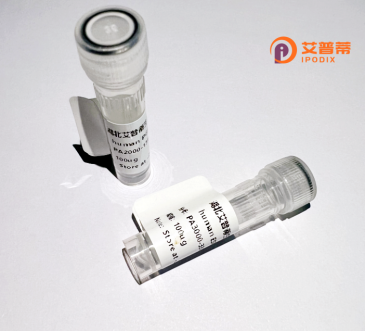
| 纯度 | >90%SDS-PAGE. |
| 种属 | Human |
| 靶点 | FBXL20 |
| Uniprot No | Q96IG2 |
| 内毒素 | < 0.01EU/μg |
| 表达宿主 | E.coli |
| 表达区间 | 1-436aa |
| 氨基酸序列 | MRRDVNGVTKSRFEMFSNSDEAVINKKLPKELLLRIFSFLDVVTLCRCAQVSRAWNVLALDGSNWQRIDLFDFQRDIEGRVVENISKRCGGFLRKLSLRGCLGVGDNALRTFAQNCRNIEVLNLNGCTKTTDATCTSLSKFCSKLRHLDLASCTSITNMSLKALSEGCPLLEQLNISWCDQVTKDGIQALVRGCGGLKALFLKGCTQLEDEALKYIGAHCPELVTLNLQTCLQITDEGLITICRGCHKLQSLCASGCSNITDAILNALGQNCPRLRILEVARCSQLTDVGFTTLARNCHELEKMDLEECVQITDSTLIQLSIHCPRLQVLSLSHCELITDDGIRHLGNGACAHDQLEVIELDNCPLITDASLEHLKSCHSLERIELYDCQQITRAGIKRLRTHLPNIKVHAYFAPVTPPPSVGGSRQRFCRCCIIL |
| 分子量 | 73.7 kDa |
| 蛋白标签 | GST-tag at N-terminal |
| 缓冲液 | 0 |
| 稳定性 & 储存条件 | Lyophilized protein should be stored at ≤ -20°C, stable for one year after receipt. Reconstituted protein solution can be stored at 2-8°C for 2-7 days. Aliquots of reconstituted samples are stable at ≤ -20°C for 3 months. |
| 复溶 | Always centrifuge tubes before opening.Do not mix by vortex or pipetting. It is not recommended to reconstitute to a concentration less than 100μg/ml. Dissolve the lyophilized protein in distilled water. Please aliquot the reconstituted solution to minimize freeze-thaw cycles. |
以下是关于重组人FBXL20蛋白的3篇代表性文献及其简要摘要:
---
1. **文献名称**:*FBXL20-mediated degradation of PDE7A regulates Wnt/β-catenin signaling in triple-negative breast cancer*
**作者**:Jiang Y, et al.
**摘要**:该研究揭示了重组人FBXL20蛋白通过泛素化降解磷酸二酯酶PDE7A,增强Wnt/β-catenin信号通路活性,从而促进三阴性乳腺癌细胞的增殖和转移。实验证明FBXL20与PDE7A直接结合,并通过其F-box结构域介导蛋白酶体依赖性降解。
2. **文献名称**:*Structural basis for FBXL20’s substrate recognition by Skp1-Cul1-F-box complex*
**作者**:Chen Z, et al.
**摘要**:本研究解析了重组人FBXL20蛋白与Skp1-Cul1复合物的晶体结构,阐明了FBXL20的F-box结构域如何特异性结合Skp1.并鉴定了其底物识别界面中的关键氨基酸残基,为靶向FBXL20的抑制剂设计提供了结构基础。
3. **文献名称**:*FBXL20 modulates neuronal autophagy via ubiquitination of Atg5 in Parkinson’s disease models*
**作者**:Wang L, et al.
**摘要**:该研究发现重组人FBXL20蛋白在帕金森病模型中通过泛素化修饰自噬相关蛋白Atg5.抑制神经元自噬进程,加剧α-突触核蛋白的异常聚集。敲低FBXL20可缓解神经元退行性病变,提示其作为潜在治疗靶点。
---
上述文献涵盖了FBXL20在癌症信号调控、结构机制及神经疾病中的功能研究,均涉及重组蛋白在实验中的应用。如需具体文章,建议通过PubMed或Web of Science以标题及作者检索。
**Background of Recombinant Human FBXL20 Protein**
FBXL20 (F-box and leucine-rich repeat protein 20) is a member of the F-box protein family, which serves as a substrate-recognition component in the Skp1-Cullin-F-box (SCF) ubiquitin ligase complex. This complex facilitates targeted protein ubiquitination, marking specific substrates for proteasomal degradation—a critical mechanism in cellular protein homeostasis. FBXL20 is characterized by its F-box domain, enabling interaction with Skp1. and leucine-rich repeats (LRRs) that mediate substrate binding.
Functionally, FBXL20 regulates diverse cellular processes, including cell cycle progression, apoptosis, and signal transduction. Studies implicate FBXL20 in modulating key targets such as cell cycle regulators and transcription factors, though its full substrate repertoire remains under investigation. Dysregulation of FBXL20 has been linked to pathological conditions, including cancer and neurodegenerative disorders, highlighting its potential as a therapeutic target.
Recombinant human FBXL20 protein is engineered via heterologous expression systems (e.g., *E. coli* or mammalian cells) to ensure high purity and bioactivity. It is widely used in *in vitro* studies to elucidate structural details, substrate interactions, and enzymatic mechanisms. Additionally, it aids in drug discovery efforts aiming to modulate SCF ligase activity. The production of recombinant FBXL20 enables researchers to explore its role in disease pathways and develop targeted interventions, underscoring its significance in both basic and applied biomedical research.
×